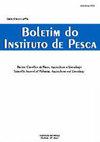综合多营养化水产养殖中浮游动物群落动态对水体营养状态的响应
IF 0.6
4区 农林科学
Q4 FISHERIES
引用次数: 1
摘要
综合多营养水产养殖(IMTA)是一种将不同营养水平的物种组合在一起优化水产养殖饲料利用的替代手段。在IMTA中添加底物也被用来促进磷的降低释放,从而最大限度地减少富营养化和污水的影响。在这些水产养殖系统中,浮游动物群落很重要,因为它是营养链中的一个环节。本研究旨在探讨罗非鱼-对虾群落在不同基质土池营养条件下的动态变化及其结构。研究对象是12个土池,分为三种处理:无基质(对照)、土工布基质和竹基质。浮游动物样本每两周通过舱底水泵采集一次。对轮虫和微甲壳类动物进行了鉴定和计数,以确定实验期间群落多样性的变化。富营养化通过水体磷和叶绿素浓度测定。不同处理的浮游动物群落没有差异,尽管系统富营养化水平的增加通过改变其多样性和丰度严重影响了该群落。多养富营养化条件下最具代表性的是小生物。本文章由计算机程序翻译,如有差异,请以英文原文为准。
Zooplankton community dynamics in response to water trophic state in integrated multitrophic aquaculture
Integrated multitrophic aquaculture (IMTA) is an alternative means to optimize feed usage in aquaculture which combines species of different trophic levels. The addition of substrate to IMTA has also been used to promote a lower release of phosphorus, thus minimizing eutrophication and impacts of effluents. In these aquaculture systems, the zooplankton community is important because it acts as a link in trophic chains. This study aimed to verify the dynamics and the structure of the zooplankton community in IMTA (tilapia-prawn), in response to trophic conditions in earthen ponds with different substrates. The object of the study was 12 earthen ponds organized in three treatments: no substrate (control), geotextile substrate, and bamboo substrate. Zooplankton samples were taken biweekly through a water bilge pump. Rotifers and microcrustaceans were identified and counted to determine changes in community diversity during the experiment. Eutrophication was determined through phosphorus and chlorophyll water concentrations. There were no differences in zooplankton communities among treatments, even though increases in levels of eutrophication of the system heavily influenced this community, by altering its diversity and abundance. Small organisms were the most representative ones under polyculture eutrophic conditions.
求助全文
通过发布文献求助,成功后即可免费获取论文全文。
去求助
来源期刊

Boletim do Instituto de Pesca
FISHERIES-ZOOLOGY
CiteScore
0.80
自引率
0.00%
发文量
24
审稿时长
>12 weeks
期刊介绍:
To publish original articles of research and short communications in the following áreas: Fisheries, Aquaculture, Zootechnology, Limnology, Oceanography, Biology and Pathology of aquatic organisms. The publication depends on the approval of the Editorial Board, based on the peer review.
 求助内容:
求助内容: 应助结果提醒方式:
应助结果提醒方式:


